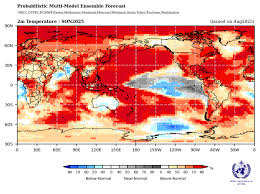
Published September 9, 2025
🌡️ Counter-Report: Reevaluating the WMO’s Outlook on La Niña and Global Temperatures
Introduction
The World Meteorological Organization (WMO) has recently projected a 55% chance of La Niña conditions developing between September and November 2025, with a slight increase to 60% for October–December 2025. Despite this potential cooling in the equatorial Pacific, the WMO maintains that global temperatures are expected to remain above average.
However, this outlook warrants a closer examination, especially considering the complex interplay between oceanic conditions and global temperature trends.
La Niña’s Impact on Global Temperatures
La Niña is characterized by cooler-than-average sea surface temperatures in the central and eastern Pacific Ocean. This phenomenon typically leads to a temporary reduction in global average temperatures due to the ocean’s role in absorbing heat. While the WMO acknowledges this cooling effect, it suggests that the influence of La Niña may be insufficient to offset the overarching trend of rising global temperatures.
However, historical data indicates that La Niña events have, at times, contributed to significant short-term reductions in global temperatures. For instance, the 2010–2012 La Niña event was associated with a notable dip in global temperatures. Therefore, even a moderate La Niña event could have a more pronounced cooling effect than currently anticipated.
The Role of Oceanic Conditions
The WMO’s forecast is based on sea surface temperature anomalies in the equatorial Pacific. However, oceanic conditions are influenced by a multitude of factors, including subsurface temperatures and ocean currents, which are not fully captured in surface-level measurements. Recent studies have highlighted the importance of these subsurface conditions in determining the overall heat content of the ocean and, by extension, global temperatures. Therefore, a comprehensive assessment of oceanic conditions may reveal a stronger potential for cooling than the WMO’s surface-level analysis suggests.
Climate Change Considerations
The WMO’s statement does not fully account for the potential interactions between La Niña and ongoing climate change. While the organization notes that climate change is increasing the frequency of extreme El Niño events, it does not provide a similar analysis for La Niña events. Given the increasing frequency and intensity of extreme weather events associated with climate change, it is plausible that La Niña events could also become more pronounced, leading to more significant cooling effects.
The video presents a nuanced analysis of the potential return of La Niña in late 2025, but it also highlights several points that cast doubt on the WMO’s confident projections of above-average global temperatures despite La Niña conditions.
-
Weak La Niña Signals:
-
The meteorologist emphasizes that the developing La Niña is expected to be weak. Historically, weak La Niña events often fail to produce the canonical cooling effects, meaning global temperatures could behave unpredictably.
-
This directly challenges the WMO’s framing that above-average global temperatures are a “given,” showing that natural variability could still lead to significant deviations.
-
-
Uncertainty in Forecasting:
-
The video repeatedly notes the high uncertainty inherent in seasonal forecasts. Even expert predictions assign roughly a 50/50 chance to La Niña vs. ENSO-neutral outcomes, illustrating that the WMO’s projections are far from guaranteed.
-
This highlights the caution needed before interpreting statements about future global temperature trends.
-
-
Global Warming May Overpower ENSO:
-
While WMO mentions global warming, the video clarifies that it complicates the usual ENSO effects. In some regions, La Niña’s cooling influence could be entirely negated, while in others, it may exacerbate extreme events.
-
This suggests that projecting “above-average temperatures despite La Niña” is speculative, not certain.
-
-
Regional Variability Matters:
-
The video underscores that La Niña impacts vary widely by region. While some areas may experience cooler conditions, others could see unusual heat or dryness.
-
This questions the WMO’s global averages, which may obscure local anomalies and overgeneralize the expected climate outcome.
-
 Overall Takeaway:
Overall Takeaway:
While the WMO’s forecast is based on current data and models, it may not fully capture the complexities of oceanic conditions and their interactions with global temperatures. A more nuanced analysis, considering subsurface oceanic conditions and the potential impacts of climate change on La Niña events, may suggest a greater likelihood of global temperature reductions than currently projected. Therefore, it is essential to approach the WMO’s outlook with caution and consider alternative scenarios that account for these complexities.
SOURCES: WORLD METEOROLOGICAL ORGANIZATION – La Niña may return but temperatures are likely to be above average





Be the first to comment